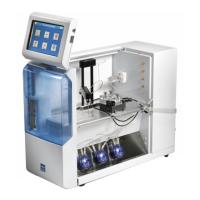105
8.2.4 D-Glucose (Dextrose)
This is a direct reading of glucose in solution at the enzyme sensor. The enzyme glucose oxidase is immobilized in the
enzyme membrane.
Glucose + O
2
Glu Oxidase
H
2
O
2
+ D-Glucono-δ-Lactone
Color
Dark red
Detection
Range
at 13, 15 & 25 µL
sample size
0.05–18.0 g/L
at 10 µL sample size
(1.80 g/L Cal Point)
0.05–25.0 g/L
at 10 µL sample size
(2.50g/L Cal Point)
Point
2.50 g/L
Point
9.0 g/L
(CV,n=10)
whichever is greater
Linearity
(0.05 to Cal Point)
±5%
(Cal Point to Range Max)
Life
21 days
Note: See Appendix B – Concentration
Unit Conversion if concentration unit
conversion is required.
• If sample dilution is required, use reagent water.
• If a solution must be prepared from solid glucose, use
the following diluent and allow about 15 minutes
before measuring the sample. This is required for
glucose, which must equilibrate alpha and beta
anomers (mutarotational equilibrium). If your reading
is lower than expected, you may need to wait slightly
longer for equilibration.
Diluent: 40 g/L NaH
2
PO
4
10 g/L Na
2
HPO
4
Reagent water
Both heat and the presence of phosphate accelerate
mutarotational equilibration.
• For applications requiring linearity performance to
25.0 g/L, YSI 2777 (25.0 g/L glucose, 2.50 g/L lactate)
may be used as a linearity standard provided the
calibrator is YSI 2776 (2.50 g/L glucose, 0.50 g/L
lactate) and the sample size is 10 µL.
• For applications requiring linearity performance to
18.0 g/L, YSI 2748 (18.0 g/L glucose, 1.78 g/L lactate)
may be used as a linearity standard provided the
sample size is 10 µL.

